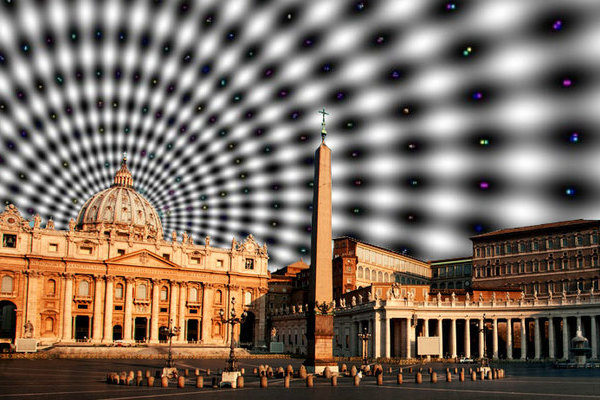Our perceptions are fallible and we sometimes see what isn't there. We all fall prey to optical illusions, and that's what makes these illusions hidden around Rome so much fun.
Find the secrets hidden by the masters throughout the centuries
You've seen the Sistine Chapel, St. Peter's Basilica, the Colosseum, Roman Forum, and the Pantheon - but you may have missed these secrets hidden around town. The Eternal City, among its artwork and ancient ruins, hides a number of antique optical illusions, created by the masters, still waiting to be discovered. Go with your private guide for an in-depth explanation of each site or become the guide yourself and surprise your fellow travelers with your knowledge of what we like to call, 'secret Rome,' visiting sites traditionally only known by the locals.
THE "PICCOLOMINI" AND THE SHRINKING CUPPOLA
Via Nicolò Piccolomini
Among the hidden ‘must-dos’ of Rome, there is this view of St. Peter’s Dome from a different perspective than most visitors see it. In our opinion, the most spectacular way to see the “cupola” is via Niccolò Piccolomini.
Starting from Rome’s famous park, Villa Pamphili, you will find via Piccolomini atop a residential hillside, where you can admire a beautiful view of Rome characterized by the giant St. Peter’s Dome. Here comes the magic.
If you start at the end of the street, as you approach the dome, it will actually appear to get smaller (rather than bigger), and you will experience the same effect if you walk opposite direction- the dome will get larger the farther you are from it.
But is it really magic?
Probably not, and it is generally agreed that it is a trick of perspective caused by the position and height of the buildings along the street, as well as the road’s width. When you walk towards a focal point, such as St. Peter’s dome, one would expect it to get bigger the closer you get. But in this case, on the contrary, the cupola appears to become smaller as we approach the space between the buildings gets wider and our brain adjusts the dimensions perceived automatically.
Via Piccolomini is one of Rome’s most fascinating places, and we consider it a great way to end the day in a very romantic, and magical setting.
THE "FALSUS DOMUS" OF ANDREA POZZO
Sant'Ignazio Church
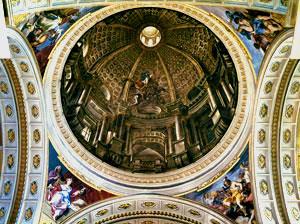 Perhaps even lesser known by the general public is the church of St. Ignazio di Loyola where the optical illusion can be seen inside of its cupola.
Perhaps even lesser known by the general public is the church of St. Ignazio di Loyola where the optical illusion can be seen inside of its cupola.
The architects in charge of the construction of the church had issues with the space, and the limited funds could not permit the construction of the church’s dome.
However, the architect, Andrea Pozzo was able to masterfully compensate for this lack of funds and space by playing with perspective.
Both of these illusions must be seen in person to be truly appreciated, so next time you’re in Rome don’t miss this church!
When you first enter the church it is difficult to tell there is not a real dome, and as you walk towards the crossing, if you are paying attention, you will see that the dome is just actually a flat surface painted to give the perspective of space.
This is not the only illusion he created, if you look closely at the church’s ceiling you will notice that it is not as high as it appears. Again, by using perspective, he extended its apparent height by a meter or so- but you probably didn’t notice because you were distracted by the busy scene of angels in the heavens.
Of course, both of these illusions must be seen in person to be truly appreciated, so next time you’re in Rome don’t miss this church!
THE AVENTINE KEYHOLE
The Priory of the Knights of Malta
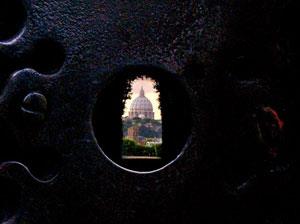 The next secret we want to reveal here is not a proper illusion but we think it is really deserving of ‘honorable mention’ as one of the most unique views available to guests in Rome.
The next secret we want to reveal here is not a proper illusion but we think it is really deserving of ‘honorable mention’ as one of the most unique views available to guests in Rome.
Set upon one of the famous seven hills of Rome, the Aventino, is the Giardino degli Aranci (the Orange Garden), from where you can enjoy a beautiful view of St. Peter’s Dome and have a wonderful walk among the fragrant Orange trees.
The Garden was created by Raffaello de Vico in 1932 for the Dominican friars who used it as a vegetable garden.
The Aventine Keyhole and the Orange Garden are sure to be a highlight of any trip to Rome. A few steps away from the garden is the door to the Priorato dei Cavalieri di Malta (Priory of the Knights of Malta) with its famous keyhole from which it is possible see St. Peter’s Dome.
The hedge inside was deliberately planted and maintained to perfectly frame the dome for an unforgettable view that will surely be one of the highlights of your trip.
FORCED PERSPECTIVE OF FRANCESCO BORROMINI
Palazzo Spada
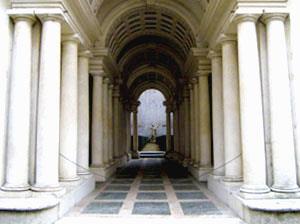 Palazzo Spada is the head office of the Consiglieri di Stato (the Italian State Council), and the gallery inside houses another of Rome’s interesting illusions.
Palazzo Spada is the head office of the Consiglieri di Stato (the Italian State Council), and the gallery inside houses another of Rome’s interesting illusions.
If you step into the corridor of the gallery at the entrance, in front of you, at the end of the corridor, you will see a statue of the god Mars. Your first impression is that the corridor is very long and the statue very tall.
In reality, the corridor is only 8-9 meters long instead of the 30 or so which it seems, and the statue is less than 60 cm tall. Only if you go there and you walk down the corridor yourself will you experience this effect.
The optical illusion in this case was left to us by the great master Borromini who took advantage of the perspective given by the ceiling, floor and columns along the corridor, that lead the eye to the central point- the statue of Mars.
Only if you go there and you walk through the corridor yourself will you experience this effect. We’d love to hear what you think!
THE DISAPPEARING COLUMNS OF THE VATICAN
St. Peter's Square
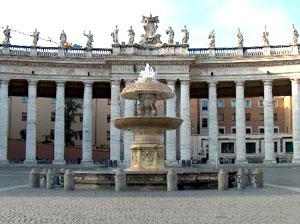
St. Peter’s Square is one of the most famous locations in the world and is visited, in part, for its magnificent architecture.
A grand colonnade consisting of three rows of columns around the square seemingly leads us to St. Peter’s Basilica, but not everyone notices the marble markers set in the ground at various points around the square.
On one of these markers, an inscription says, “centro del colonnato” (the center of the colonnade) upon which an observer can stop and inspect the colonnade from this point.
Instead of three rows of columns, you will find that only one row is visible- the other two seem to have disappeared!
St. Peter’s Square is one of the most famous locations in the world and is visited, in part, for its magnificent architecture. This famous optical illusion is owed to the genius of Bernini created by perspective and specifically, vanishing points. If you leave the marker and walk in any direction, you immediately notice that hidden columns begin to reappear.
Learn more about the St. Peter's Basilica during our Vatican Museums Early Morning Prime: VIP Experience.
This is one of the most famous illusions in Rome, at one of its most visited sites, and which the majority of visitors miss- but not you!
THE SHRINKING SQUARES OF THE PANTHEON
Ceiling The Pantheon
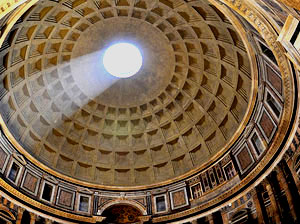 Dedicated to the gods of Olympus, the Pantheon was first built by Marcus Agrippa, the advisor and son-in-law of Emperor Augustus.
Dedicated to the gods of Olympus, the Pantheon was first built by Marcus Agrippa, the advisor and son-in-law of Emperor Augustus.
The dedication occurred between 27 and 25 A.D., during the third consulate of Agrippa, as recorded in an inscription still visible on the front of the building: M·AGRIPPA·L·F·COS·TERTIVM·FECIT, which means “Built by Marcus Agrippa, son of Lucius, consul for the third time."
The Pantheon’s dome was probably designed to recall the temple on Mt. Olympus and the 7 niches all around the structure displayed the statues of the gods to whom the temple was dedicated.
The only light source is the ‘oculus’ or eye, the circular opening, 8.2 meters in diameter.
The Oculus is considered to be the most extraordinary aspect of the Pantheon's architecture and helped to create a heavenly light effect. In any case, the great Pantheon and its architecture is sure to take your breath away. Here is where our final illusion is found. As you look up at the ceiling coffers (the squares in the ceiling of the dome) you will notice that they appear to get smaller as they get closer to the great oculus. Surely this is an optical illusion done to increase the perceived size of the already massive dome…right? In reality, there is no intentional optical illusion in play here.
The dome is massive, and its coffers are each the same size, it’s just the large space that they occupy that gives us this effect.
In any case, the great Pantheon and its architecture is sure to take your breath away.
Are you ready to live the magic? Choose your favorite illusion and choose one of our Rome Private Tours!


